Tech
Sennheiser Momentum True Wireless 4 wishlist: All the features I want to see

The Sennheiser Momentum True Wireless 3 champion high-end features their predecessors could only dream of. Chief among them is improved noise canceling that now rivals the likes of Sony, Samsung, and Bose. They also sport stabilizing ear fins for greater security during workouts. Their sound profile also closely follows our consumer curve in the bass and midrange. With such a rich feature set, it is not surprising the Momentum True Wireless 3 are among the best wireless earbuds money can buy. Nevertheless, nothing is truly perfect. Here is everything I want to see Sennheiser bring to the updated Sennheiser Momentum True Wireless 4.
A secure and comfortable fit

Finding the touch control area is easy; it’s on the Sennheiser logo.
Few earbud manufacturers offer as much customization as Sennheiser with the Momentum True Wireless 3. Users gain four silicon ear tips from 10mm – 15mm in diameter out of the box. The buds also come equipped with three sets of silicone wings to help secure a snug fit. Replacing the ear tips is a breeze and takes minimal effort to fit over the 7mm earbud nozzle.
However, the earbuds’ bulky design can make them hard to place securely inside the ear canal. The earbuds also weigh 7g more than their predecessor. Both specifications mean rigorous exercise, such as jogging, is a non-starter. Furthermore, the buds’ 15mm size makes it more likely you will suffer ear fatigue if worn over long periods. I want Sennheiser to bring a smaller and lighter form factor to the Momentum True Wireless 4. The company could also learn from the Jabra Elite 8 Active and adopt a rubberized coating. This could help Sennheiser ditch the ear wings in favor of a more slender, gripper build.
A detailed custom EQ
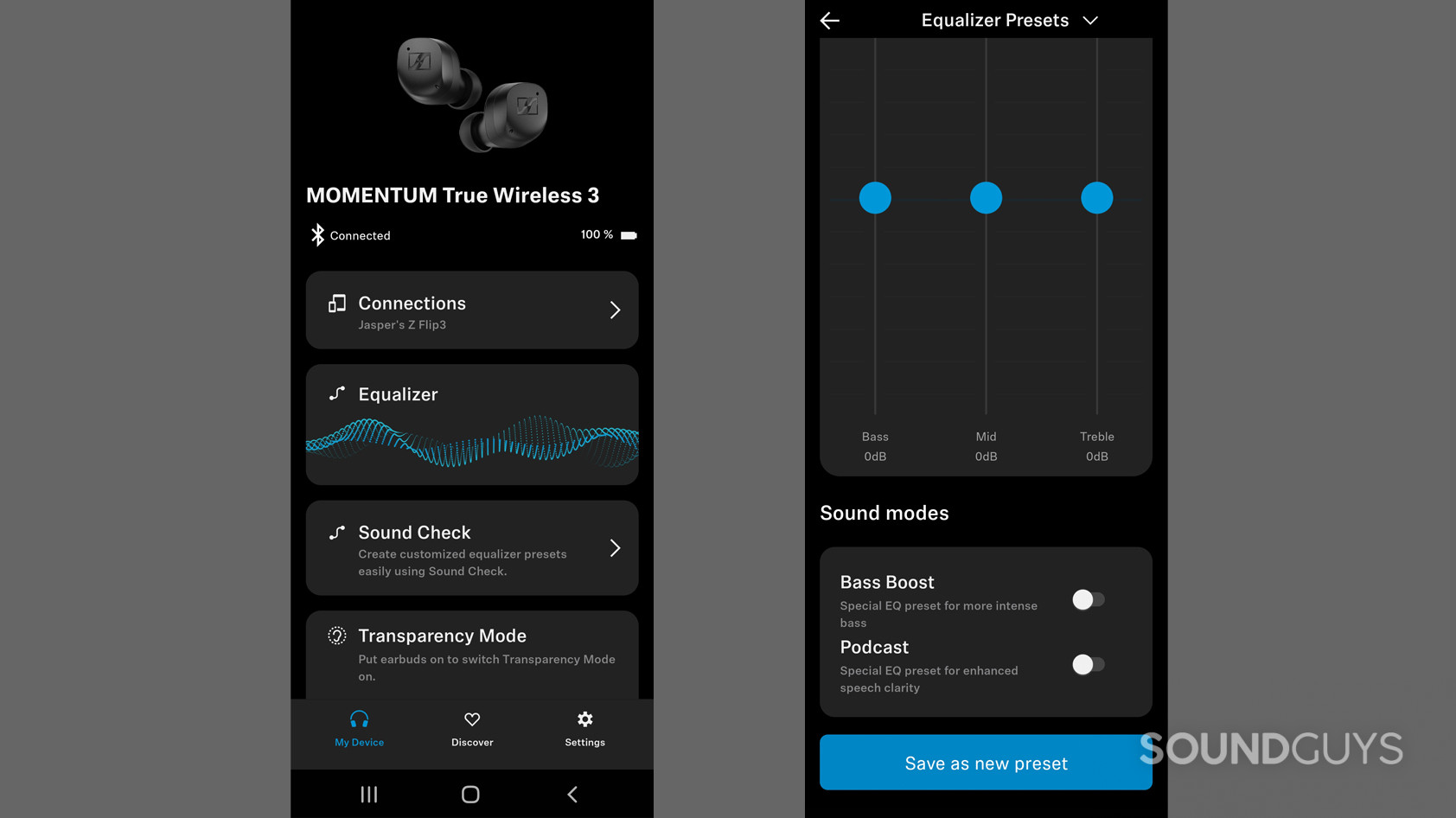
On the left is the main menu, and on the right is the basic equalizer. What, for instance, does Sennheiser classify as treble?
In a world with ever more walled gardens, it is always worth singing the praises of OS-agnostic devices. Sennheiser’s Smart Control app works seamlessly with iOS and Android to control connected devices, firmware updates, Sound Check, Transparency Mode, “Adaptive Noise Cancellation,” “Sound Zones,” and Touch Controls. The app tiles can even be reorganized to your specifications, which is handy.
Herein lies the “but.” Despite Sennheiser including a custom EQ, it has a strikingly limited set of adjustable parameters. For example, there are only three sliders to control: Bass, Mid, and Treble. The volume of each can be adjusted up or down by a maximum of 6dB – less than many competitors and third-party EQ apps. It is also unclear which specific frequencies these bands adjust. This makes it difficult to hone your sound or to dial out a particularly unwanted frequency. When spending upwards of $249, it is fair to expect more than just Bass Boost and Podcast presets, too. Sennheiser will need to bring a more detailed multiband EQ to the Sennheiser Momentum True Wireless 4 if it wants to stay in the race with Sony, Bose, and Samsung.
More reliable wireless connectivity

The new stabilizers help give the MOMENTUM True Wireless 3 a more universal fit than its predecessor.
The Sennheiser Momentum True Wireless 3 provide a more comprehensive list of Bluetooth codecs than many of their competitors. For example, the company released an update allowing 24-bit/96kHz streaming via aptX Adaptive on November 2, 2022. The earbuds also include SBC, AAC, and aptX wireless connectivity options. With such a wide pool of codecs, the Sennheiser Momentum True Wireless 3 even make it among some of the best earbuds for iPhone owners.
However, there are caveats. For example, streaming over the aptX Bluetooth codec yields little more than eight meters of connectivity. Anything beyond this distance begets audio dropouts and stuttering playback. Even more worrisome is the prevalence of connectivity issues from as little as one meter. While this may not affect every user to the same extent, it proves that the earbuds are not as stable as they should be. Given Sennheiser’s Momentum True Wireless brand represent its top-tier line, I expect the Sennheiser Momentum True Wireless 4 to retain more reliable wireless connectivity than their predecessors.
More pronounced treble frequencies
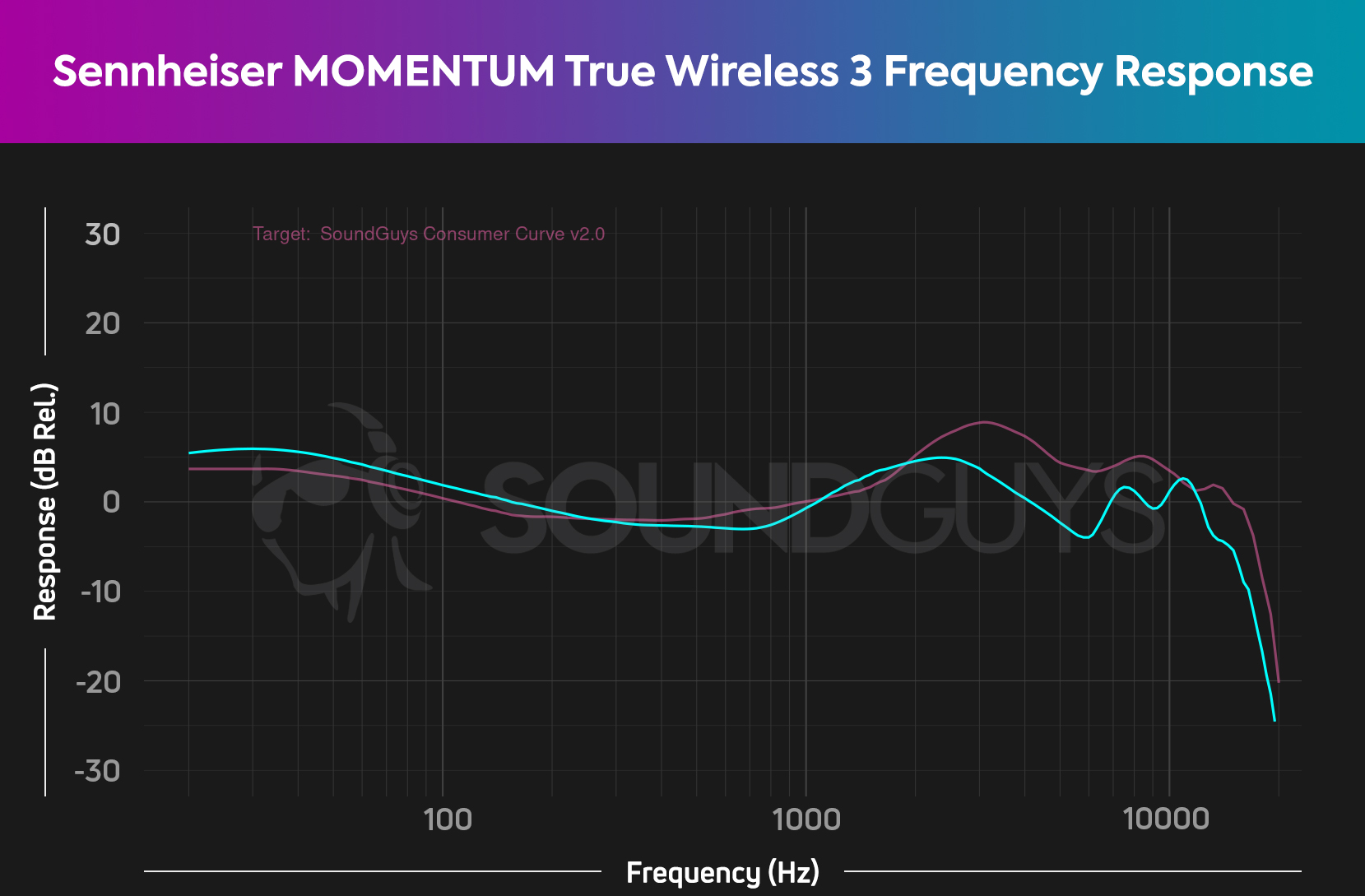
The MOMENTUM True Wireless 3 (in cyan) follows our target curve (in pink) closely, except for the highs.
Regarding audio quality, Sennheiser headphones stand proud as some of the best in the business. The same is true for the Momentum True Wireless 3. Generally speaking, the company’s flagship buds have a pleasing frequency response. As you can see, it closely follows our preference curve above (shown in pink.) This helps the Momentum True Wireless 3 complement a variety of music genres. Furthermore, the oft-over-accentuated bass response of other earbuds is comparatively tame here. This leads to less auditory masking and the reproduction of finer musical details.
However, as you can see in the chart above, there is some deviance from our preference curve in the highs. From around 2.5 – 10kHz, the Sennheiser Momentum True Wireless 3 under-emphasizes treble frequencies by almost 10dB. While this helps reduce sibilance and ear fatigue, it also reduces the prominence of vocals and keys in the mix. Given the simplicity of the Sennheiser Smart Control app EQ, adjusting the treble slider may not yield the desired effect, either. The Sennheiser Momentum True Wireless 4 would benefit from a slightly more accentuated treble response while retaining its pleasing bass and mid-range curve.
Improved battery life
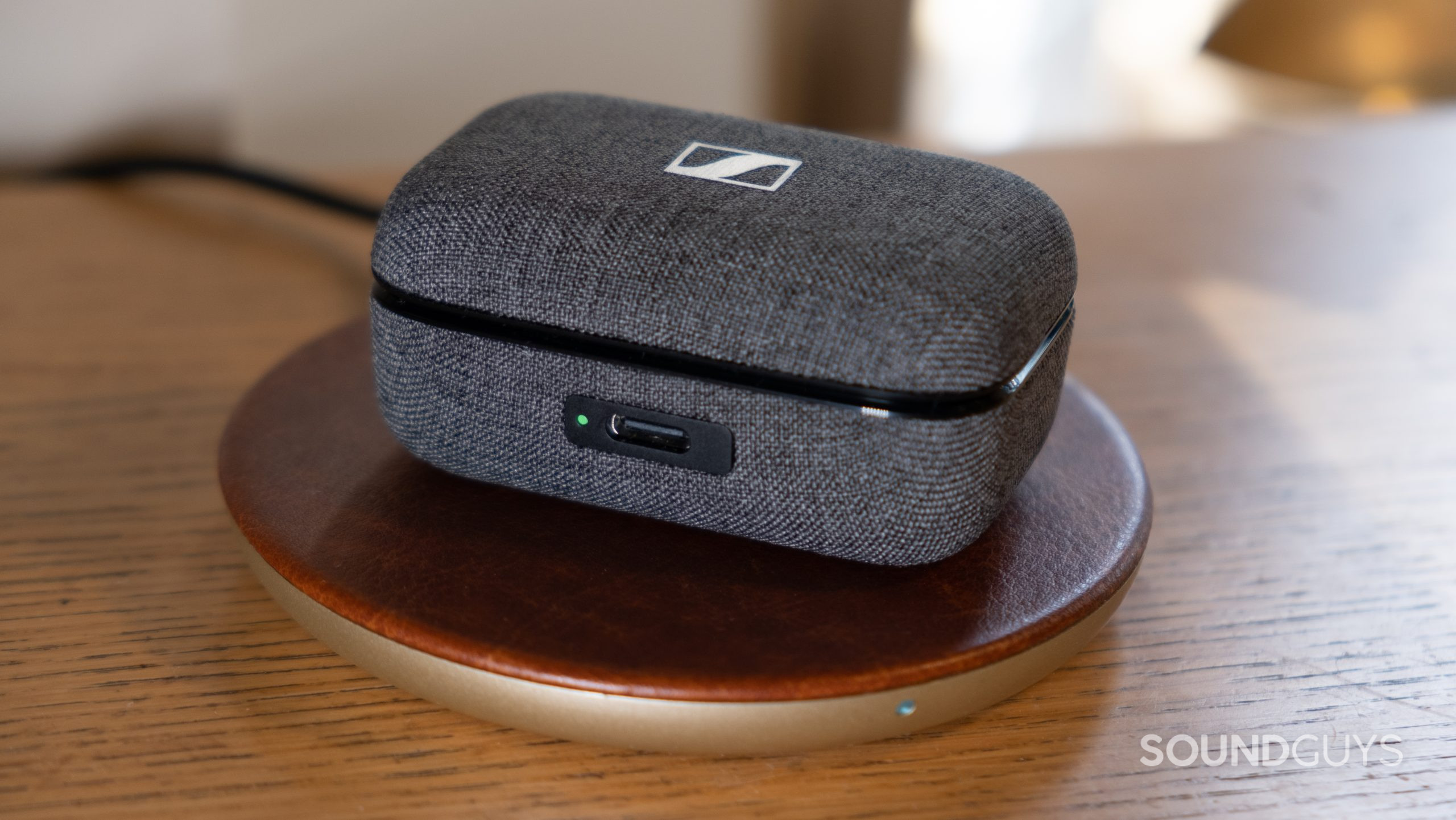
The charging pad doesn’t come with the package, but if you have one already it’s handy.
The average battery life of wireless earbuds sits around the four-to-five-hour mark. The original Momentum True Wireless buds run under four hours, while the middle sibling last nigh on four hours. The company’s most recent Momentum True Wireless 3 last significantly longer, yielding five hours and 33 minutes of playback time. The charging case delivers three extra charging cycles, totaling 22 hours of battery life. You can pop the buds on a Qi wireless pad or go traditional with wired boosting via USB-C. A quick 10-minute top-up delivers 60 minutes of juice.
This all sounds great on paper. However, other similarly-priced earbuds deliver greater battery life without a hitch. Take, for example, the Sony WF-1000XM5. These high-end earbuds support eight hours of playtime on a single charge and cost only $50 more. Further, the Anker Soundcore Liberty 4 NC provide nearly 10 hours of charge for less than half the price. If Sennheiser wants to compete for the lion’s share, the Sennheiser Momentum True Wireless 4 will need even greater battery life at launch.
What would you like to see Sennheiser bring to the Sennheiser Momentum True Wireless 4?
12 votes
A secure and comfortable fit
33%
A detailed custom EQ
25%
More reliable wireless connectivity
17%
More pronounced treble frequencies
0%
Improved battery life
8%
Other
17%
Will there be a Sennheiser Momentum True Wireless 4?
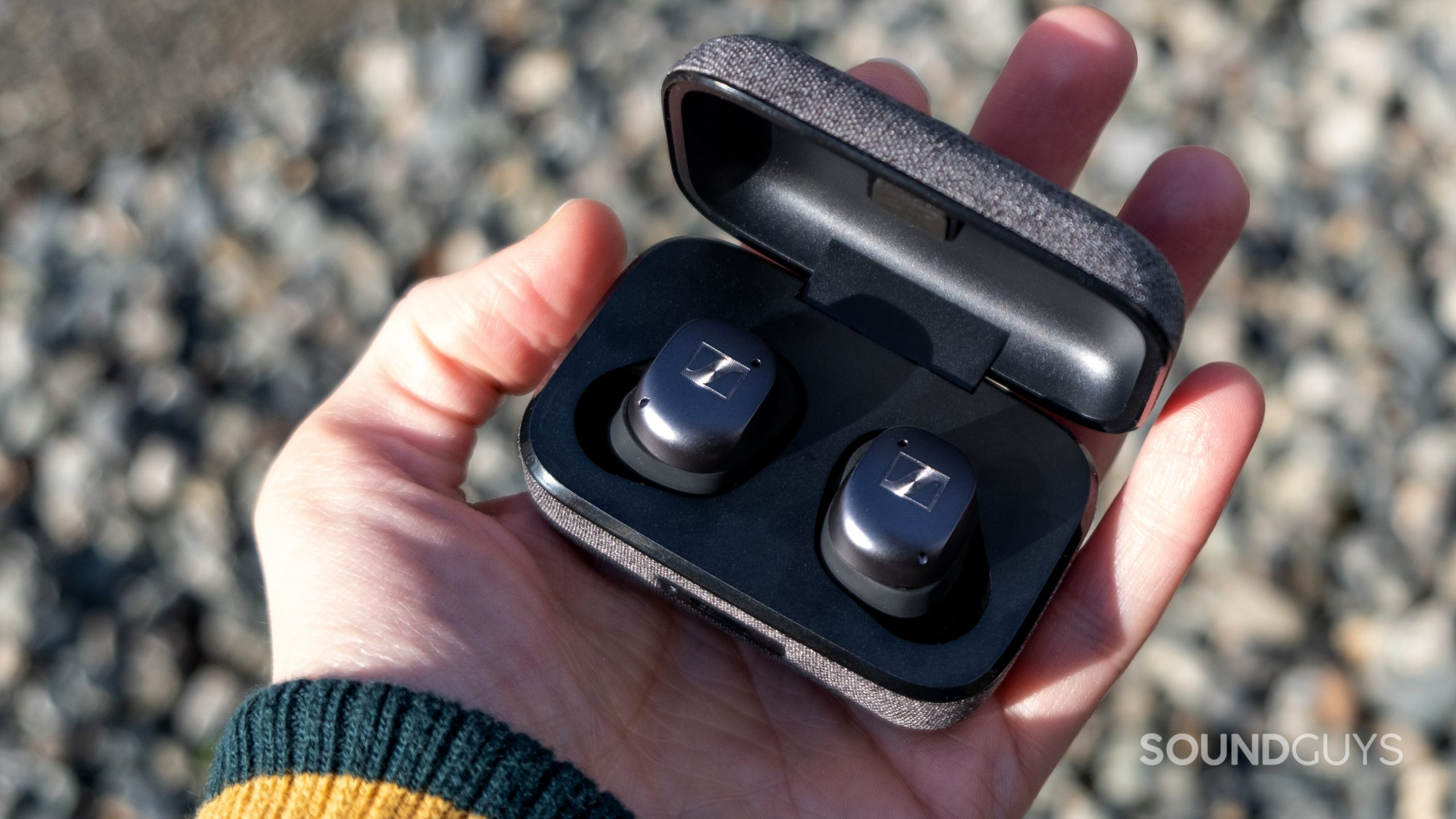
The strong case magnet hampers single-handed operation, but it also means it remains closed in your bag.
Sennheiser’s Momentum True Wireless 3 rest atop its most accomplished earbud line. While there has been no official announcement, I fully expect the Sennheiser Momentum True Wireless 4 to launch in 2024, though when exactly that will be is unknown. I’m hoping for Spring.
Sennheiser is home to an extensive catalog of true wireless earbuds. For example, the company released its athletic Sennheiser Sport True Wireless eight days after its most recent flagship earbuds. Serving as open-ear alternatives to the Momentum True Wireless 3, the Sport True Wireless prioritize environmental pass-through, a robust IP54 rating, and excellent battery life. Conversely, the Sennheiser CX Plus SE True Wireless are a bridgehead between the two. Priced at roughly $80 less than the MTW3, these earbuds pride themselves on being the best all-rounder in Sennheiser’s arsenal. With an IPX4 water-resistant rating, good noise canceling, and prominent bass response, that title seems fitting. Given that it has been over two years since each of these earbud cousins came to be, it seems like an appropriate time to get excited about the Sennheiser Momentum True Wireless 4.
- Sennheiser Momentum True Wireless — November, 2018
- Sennheiser Momentum True Wireless 2 — March 13, 2020
- Sennheiser Momentum True Wireless 3 — April 25, 2022
Running alongside its formidable headphones category, Sennheiser has consistently updated its earbud catalog over recent years. From the Sennheiser CX 400BT in 2020 to the Sport True Wireless in 2022 and everything in between, users are spoiled for choice. However, there have only been three iterations of the company’s Momentum True Wireless earbuds thus far. While it is not certain, we can surmise when the Momentum True Wireless 4 may arrive based on the company’s previous release schedule.
For example, the original Momentum True Wireless came to shelves in November 2018. Sennheiser followed up one year and four months later with the MTW2 on March 13, 2020. The company’s most recent MTW3 launched on April 25, 2022 – just over two years after their predecessor. If we stick to Sennheiser’s previous trend, we may see the Sennheiser Momentum True Wireless 4 come to shelves in the Spring of 2024. This seems especially likely given that both the MTW2 and MTW3 came to market during the springtime of 2020 and 2022, respectively.
Should you wait for the Sennheiser Momentum True Wireless 4?
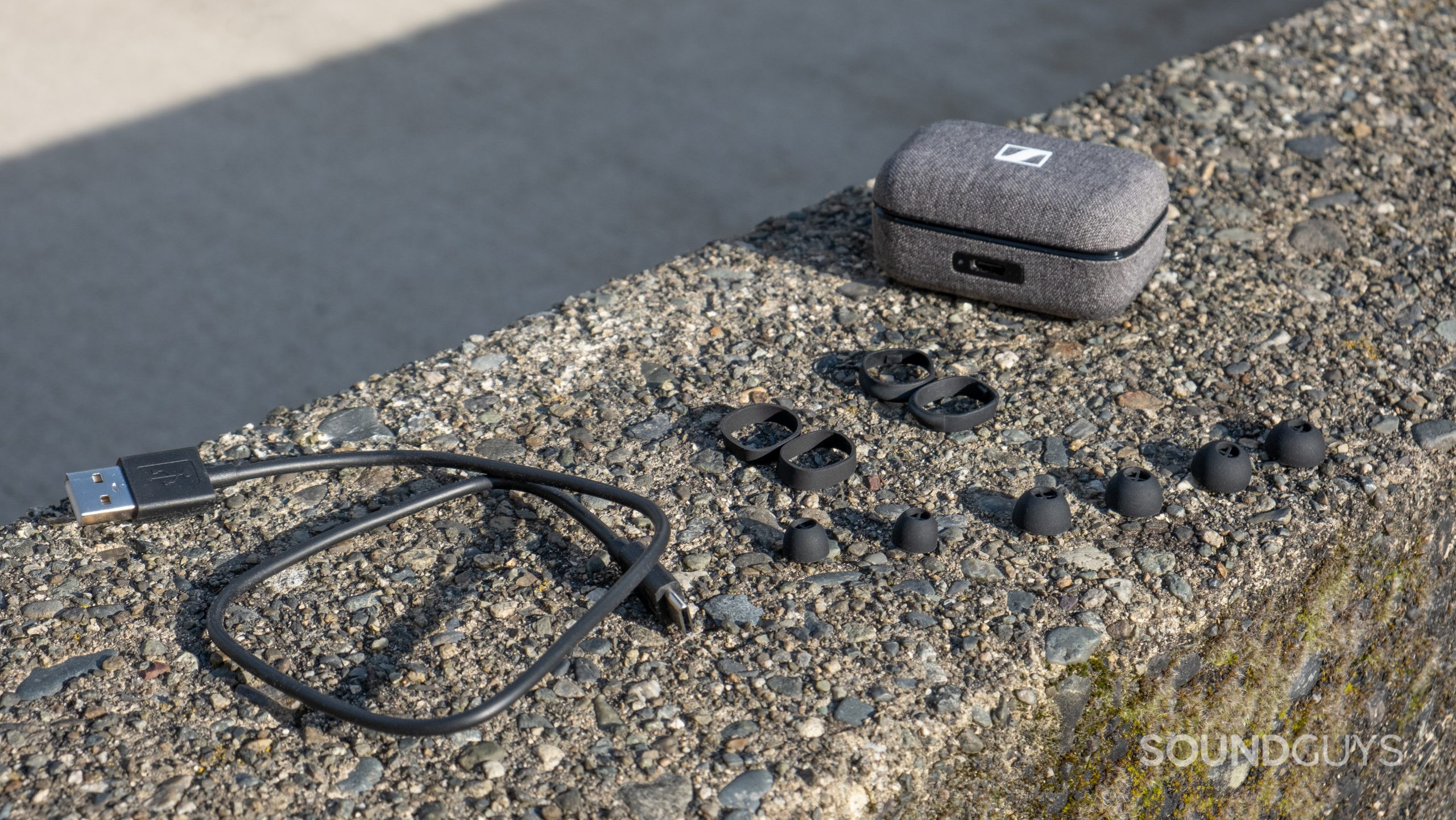
The Sennheiser Momentum True Wireless 3 are an equally solid choice whether pairing with an iPhone or Android device. Sennheiser’s Smart Control app is available on the Apple Store and the Google Play Store, and the buds support AAC and aptX connectivity for Hi-Res audio streaming. Given the company’s next-gen earbuds are expected to retail for more than the current model, it is fair to consider whether forking out for the upgrade is worth it. Besides, many other earbuds offer high-end features at a similar price point.
Sennheiser Momentum True Wireless 3

Sennheiser Momentum True Wireless 3
Great sound quality • Feature-rich app with custom EQ • Broad codec support
These feature-rich earbuds exceed all expectations.
Sennheiser Momentum True Wireless 3 show you can have great sound, great active noise-canceling, and a sturdy build all at once in a pair of true wireless earbuds.
For example, the Sony WF-1000XM5 ($298 at Amazon) come equipped with up to 50dB of noise canceling, a five-band custom EQ, Sony’s 360 Reality Audio feature, Ambient Sound, Speak-to-Chat, customizable touch controls, excellent sound quality, and Sony’s proprietary DSEE Extreme upscaling feature. The earbuds also play host to angled nozzles and flexible ear tips for improved comfort. The matte-finish touch controls are pleasant and the case and buds weigh 27.6g less than the TMW3. Like the MTW3, the WF-1000XM5 boast an IPX4 rating to protect from sweaty workouts and host nearly 10 hours of battery for long outdoor stints. Users can stream high-res wireless audio over the AAC and LDAC Bluetooth codecs. Sony’s Headphones Connect app plays just as nicely as Sennheiser’s Smart Control app on iOS and Android.
If you don’t mind parting ways with some of Sennheiser’s handy features, such as Sound Zones, then the Sennheiser CX Plus True Wireless ($89 at Amazon) are worth consideration. They deliver excellent passive isolation and up to 45dB of noise canceling. You also get a bump in the bass and mid-range frequencies, which is good if you want to use these as workout buds. Speaking of working out, the CX Plus True Wireless flex an IPX4 rating and a host of ear tip sizes, including extra small. The earbuds run Bluetooth 5.2 and offer wireless connectivity over the SBC, AAC, and aptX Bluetooth codecs. Battery life runs parallel to the MTW3 at just under six hours, and the case replenishes 16 hours of playtime when the buds run flat. The only downside is that the CX Plus True Wireless do not support wireless or fast charging.
For something a little off the radar, the Sony LinkBuds S ($148 at Amazon) are another OS-agnostic underdog. Although they sport an understated aesthetic, the buds host a pleasing matte finish that stay in your ears without the need for stabilizers. The LinkBuds S support the AAC and LDAC Bluetooth codecs, which play high-res audio nicely with Apple and Android, respectively. If you desire spatial audio, then the Sony buds have you covered here. Battery life runs almost identical to the MTW3 at just under six hours, and low-end noise canceling attenuates up to 35dB around 200Hz. Passive isolation is solid, and the default frequency curve sounds remarkably similar to the Momentum True Wireless 3.
As always, iPhone users should consider the Apple AirPods Pro (2nd generation) ($199 at Amazon) for a truly seamless user experience. Users receive one of the best out-of-the-box frequency curves on the market. Apple’s proprietary H2 chip also delivers superior ANC capable of reducing up to 30dB over a wide frequency range. The AirPods Pro 2 deliver just under six hours of charge, with the case boosting listening time by another 24 hours. For wireless charging, users can opt for a Qi, MagSafe, or Apple Watch charging mat, or connect via USB-C for wired charging. Adaptive Transparency Mode also makes a great companion when out and about, and their IPX4 water-resistant rating keeps the buds safe from rainwater and sweat. If you own an iPhone and want spatial audio, pressure-sensitive stems, and auto-wear detection, then the Apple AirPods Pro (2nd generation) are an excellent choice.

Tech
Google Unveils AI-Powered Pixel 9 Lineup Ahead of Apple’s iPhone 16 Release
Google has launched its next generation of Pixel phones, setting the stage for a head-to-head competition with Apple as both tech giants aim to integrate more advanced artificial intelligence (AI) features into their flagship devices. The unveiling took place near Google’s Mountain View headquarters, marking an early debut for the Pixel 9 lineup, which is designed to showcase the latest advancements in AI technology.
The Pixel 9 series, although a minor player in global smartphone sales, is a crucial platform for Google to demonstrate the cutting-edge capabilities of its Android operating system. With AI at the core of its strategy, Google is positioning the Pixel 9 phones as vessels for the transformative potential of AI, a trend that is expected to revolutionize the way people interact with technology.
Rick Osterloh, Google’s senior vice president overseeing the Pixel phones, emphasized the company’s commitment to AI, stating, “We are obsessed with the idea that AI can make life easier and more productive for people.” This echoes the narrative Apple is likely to push when it unveils its iPhone 16, which is also expected to feature advanced AI capabilities.
The Pixel 9 lineup will be the first to fully integrate Google’s Gemini AI technology, designed to enhance user experience through more natural, conversational interactions. The Gemini assistant, which features 10 different human-like voices, can perform a wide array of tasks, particularly if users allow access to their emails and documents.
In an on-stage demonstration, the Gemini assistant showcased its ability to generate creative ideas and even analyze images, although it did experience some hiccups when asked to identify a concert poster for singer Sabrina Carpenter.
To support these AI-driven features, Google has equipped the Pixel 9 with a special chip that enables many AI processes to be handled directly on the device. This not only improves performance but also enhances user privacy and security by reducing the need to send data to remote servers.
Google’s aggressive push into AI with the Pixel 9 comes as Apple prepares to unveil its iPhone 16, which is expected to feature its own AI advancements. However, Google’s decision to offer a one-year free subscription to its advanced Gemini Assistant, valued at $240, may pressure Apple to reconsider any plans to charge for its AI services.
The standard Pixel 9 will be priced at $800, a $100 increase from last year, while the Pixel 9 Pro will range between $1,000 and $1,100, depending on the model. Google also announced the next iteration of its foldable Pixel phone, priced at $1,800.
In addition to the new Pixel phones, Google also revealed updates to its Pixel Watch and wireless earbuds, directly challenging Apple’s dominance in the wearable tech market. These products, like the Pixel 9, are designed to integrate seamlessly with Google’s AI-driven ecosystem.
Google’s event took place against the backdrop of a significant legal challenge, with a judge recently ruling that its search engine constitutes an illegal monopoly. This ruling could lead to further court proceedings that may force Google to make significant changes to its business practices, potentially impacting its Android software or other key components of its $2 trillion empire.
Despite these legal hurdles, Google is pressing forward with its vision of an AI-powered future, using its latest devices to showcase what it believes will be the next big leap in technology. As the battle for AI supremacy heats up, consumers can expect both Google and Apple to push the boundaries of what their devices can do, making the choice between them more compelling than ever.
News
Microsoft Outage Hits Payment Processors

When major payment processing systems have problems, the issues impact many critical systems that society depends on. In this article, we’ll explain the cause of the Microsoft outage and discuss the impact computer networking issues had on Canada. We’ll also examine whether or not Microsoft was at fault and what businesses can do to prevent further outages.
What Happened With the Microsoft Outage?
The outage with Microsoft’s Azure payment processor resulted from a buggy security update from an outside company, CrowdStrike. CrowdStrike offers information technology security services for many Microsoft Windows computers. The company’s software developers sent a new update out, but instead of patching up minor issues with the existing software, the code within conflicted with Windows and prevented computers from booting up. Users expecting to start their computers for a typical day were instead faced with the dreaded “Blue Screen of Death” error message.
So, how does this produce a problem and a payment processor issue? Many computers running payment processing, among many other kinds of software used for airlines, banks, retail, and other essential services, couldn’t start and were unable to let payments through. This is a catastrophic issue for companies that are heavily reliant upon the speed and ease of an electronic transaction.
In Canada, the outage impacted critical computer systems for air travel. Flights couldn’t be paid for and booked, which caused major problems for customers unable to make transactions while flights remained grounded. Travellers stuck waiting for flights to take off made their way over to the airports’ Starbucks and other vendors, only to discover unusually long lines due to payment issues. Even online gamblers looking to take their minds off the situation couldn’t take full advantage of one of the fastest payment options out there because of the outage.
Aside from payments, hospitals for major health systems had to use paper to complete important tasks like ordering lab work and getting meals to patients. Emergency dispatch lines were temporarily unable to function correctly while their computer systems were down.
How Was the Outage Fixed?
Thankfully, CrowdStrike fixed the problem on their end quickly, mostly via an additional reboot that allowed CrowdStrike to send over unflawed code. Unfortunately, for some business and private customers, rebooting wouldn’t be enough with command-line level adjustments needed for the operating system to run correctly.
The Good and Bad of Outages
First, we’re thankful that the outage was not caused by hackers accessing and stealing a mountain of personal data. A recent outage with an automotive software provider went on for much longer and ended much worse for software provider CDK, which likely paid an undisclosed sum north of $20 million to get data back and systems restored.
By some chance, Microsoft is reported to have experienced its own outage, and many information technology professionals blame Microsoft in part for their issues because of how their systems attempted to fix the problem by rebooting over and over again, though some of Microsoft’s PCs needed to warn users to make a change manually. Unfortunately, any computer that required manual intervention took longer to recover, as a knowledgeable person had to access each computer affected by the issue. In some cases, between dealing with several hours of backlogged tasks and slow recovery processes, some businesses took days, not hours, to get back online.
The outage brings up another major point in the cybersecurity and computer industry. CrowdStrike and Microsoft are both big companies in their respective fields. As a result, the effects of bad code spread much further than they could have if there were more competitors making security products or if there were more software companies making operating systems like Windows. While only 8 million computers were believed to be affected out of a much larger global network, those are essential computers for worldwide communication and payment processing. Perhaps companies should be putting their eggs in more than one basket?
The testing methods for the outage are unclear—did CrowdStrike test the routine software update enough to detect the potential for a major outage? Apparently not.
What Should Businesses Do Next?
Software like Microsoft Azure’s payment systems come from what information technology professionals call ‘the cloud.’ The software is remotely managed over the internet, meaning that the computer that runs the system is not physically present at the location. Unfortunately, this also means that an issue with the internet can take critical systems out of service.
Businesses ranging from major airlines and banks to mom-and-pop stores would be well served by backup systems at their locations. These don’t have to be as primitive as the old-fashioned credit-card carbon-copy slide, but there are options available with consistent service that don’t repeatedly rely on the same networks.
Conclusion
There were certainly challenging moments for Canadian businesses and emergency services during the CrowdStrike and Microsoft outage. As they scrambled to understand the problem and waited, albeit briefly, for issues to resolve, many companies learned the importance of having local and reliable backup for their computer systems.
Tech
New photos reveal more details about Google’s Pixel 9 Pro Fold

Google’s secret new line of Pixel 9 phones isn’t that big of a secret anymore. Taiwan’s National Communications Commission (NCC) released new photos of the phones including the Pixel 9 Pro Fold from almost every conceivable angle.
Android Authority found the photos in the NCC archives and uploaded galleries of each of the four phones including the Pixel 9, 9 Pro, 9 Pro XL and 9 Pro Fold. They reveal some interesting details about the new Pixel phones.
The charging rates will be a little faster than the last generation of Pixel phones: Taiwanese authorities measured 24.12W for the base model, 25.20W for the Pro and 32.67W for the 9 Pro XL. The Pixel 9 Pro Fold, however, was the slowest of all of them at 20.25W. These numbers don’t often match up perfectly with the advertised ratings, so expect Google to be promoting higher numbers at its event.
Speaking of chargers, it looks like Google needed a bigger charger to power its new phones. Photos included in the NCC leak show each phone will come with a wall charger that’s around 45W depending on which model you purchase. The charger’s plug moved from the middle to the top of the brick.
The latest photo dump also shows the 9 Pro Fold unfolded for the first time. Google has moved the selfie camera to the inside screen for a wider field of view. The 9 Pro Fold also has a slimmer top and bottom, a reduced fold crease on the display and a full 180 degree unfolding angle to make a screen that’s just over 250mm or just under 10 inches.
These photos are the latest in a very long list of leaks of Google Pixel 9 photos. The last Pixel 9 leak came down yesterday showing two prototype models of the base and XL models. Google might look into buying a new combination lock for the high school locker where they apparently keep all their unreleased gear.

-

 News3 hours ago
News3 hours agoPremier says Manitoba grand chief to lie in state at provincial legislature
-

 News11 hours ago
News11 hours agoVenezuela revokes Brazil’s custody of diplomatic mission that’s housing 6 Maduro opponents
-

 News12 hours ago
News12 hours agoEnvironment solution: New metals refinery for nickel and cobalt opens in Ohio
-

 News12 hours ago
News12 hours ago‘Unstoppable’ captures Anthony Robles’ singular life, with Robles as his own stunt double
-

 News11 hours ago
News11 hours agoUS believes Iran has transferred short-range ballistic missiles to Russia
-

 News6 hours ago
News6 hours agoRepair work will keep 60-year-old ferry out of service for half a year: BC Ferries
-

 Sports13 hours ago
Sports13 hours agoCanadian para paddler Brianna Hennessy earns Paralympic silver medal
-
Health3 hours ago
4-Week Overload Conditioning Challenge


















